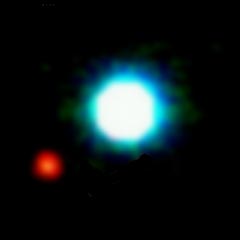
This infrared image resolves 2M 1207 into a close pair of objects; one of them is 100 times brighter than the other. Astronomers infer that their masses are 25 and 5 Jupiter masses, which would make them a brown dwarf and a planet-mass object, respectively. Both are glowing with heat left over from their formation. In this image, taken with adaptive optics on one of the 8.2-meter VLT telescopes, the infrared colors L', K, and H (at wavelengths 3.8, 2.2, and 1.6 microns) are portrayed as red, green, and blue, respectively.
Courtesy Gael Chauvin / ESO.
Astronomers have unveiled the best candidate yet for the first direct image of an extrasolar planet. If confirmed, the object will also be the first planet-mass body found orbiting a brown dwarf rather than a true star.
Last April, a team led by Gael Chauvin (European Southern Observatory) used adaptive optics on one of the 8.2-meter Very Large Telescope (VLT) reflectors in Chile to make an exceptionally sharp infrared picture of a faint brown dwarf. Lying at the Hydra-Centaurus border, 2MASS WJ1207334–393254 (or 2M 1207 for short) was originally imaged several years ago by the 2MASS infrared sky survey. The new, much better image revealed a second object only a hundredth as bright just 0.78 arcsecond to the southeast.
The excitement stems from the companion’s inferred mass. The pair seems to be part of the TW Hydrae Association, a nearby, wide-scattered group of young stars (Sky & Telescope: June 2000, page 22). The pair's distance of 230 light-years, along with the observed brightnesses and temperatures of the two objects, gives their true luminosities. All the stars of the TW Hydrae Association were born together about 8 million years ago. Knowing this, astronomers can compare the luminosity and temperature of each member of the pair with models of how substellar bodies of various masses should cool down in 8 million years.
The result: the two weigh about 25 and 5 Jupiters. This puts the faint one squarely in the realm of planet-mass objects rather than brown dwarfs. (The dividing line between them is usually defined as 13 Jupiter masses, below which not even deuterium can fuse to create heat in an object’s core.)
Their separation on the sky yields a true separation of at least 55 astronomical units, somewhat more than Pluto’s distance from the Sun. The orbital period must be at least a couple thousand years. "Just realizing that it might be the first image of another solar system is very exciting," says team member Christophe Dumas (European Southern Observatory).
In fact, the imaged objects aren’t the only things here. Michael F. Sterzik (ESO) and colleagues report that the primary, like many young brown dwarfs, shows the infrared-excess signature of a dusty protoplanetary disk orbiting it much more closely.
Other images of planet candidates have been trumpeted in the past, only to turn out to be background stars aligned by chance along our line of sight. "What’s different about this one is that they have a spectrum," says exoplanet hunter Ray Jayawardhana (University of Toronto). The spectrum indicates water vapor in the companion’s atmosphere, making it too cool to be a far-away star. And it’s extremely unlikely that a foreground or background brown dwarf would be aligned as close as 0.8 arcsecond from the primary by chance.
The real proof that the pair is a binary, though, would come from both objects moving together across the sky in parallel ("common proper motion"). Chauvin and his colleagues expect to measure the secondary’s proper motion within just a year or two. They will also try to obtain better spectra.
Many astronomers have been racing to obtain the first direct image of an exoplanet (April Sky & Telescope cover story), but none with confirmed success. Team member Benjamin Zuckerman (UCLA) thinks that’s about to change. "As instruments improve, I think we’re going to see more and more of these discoveries made," he says.
 0
0
Comments
You must be logged in to post a comment.